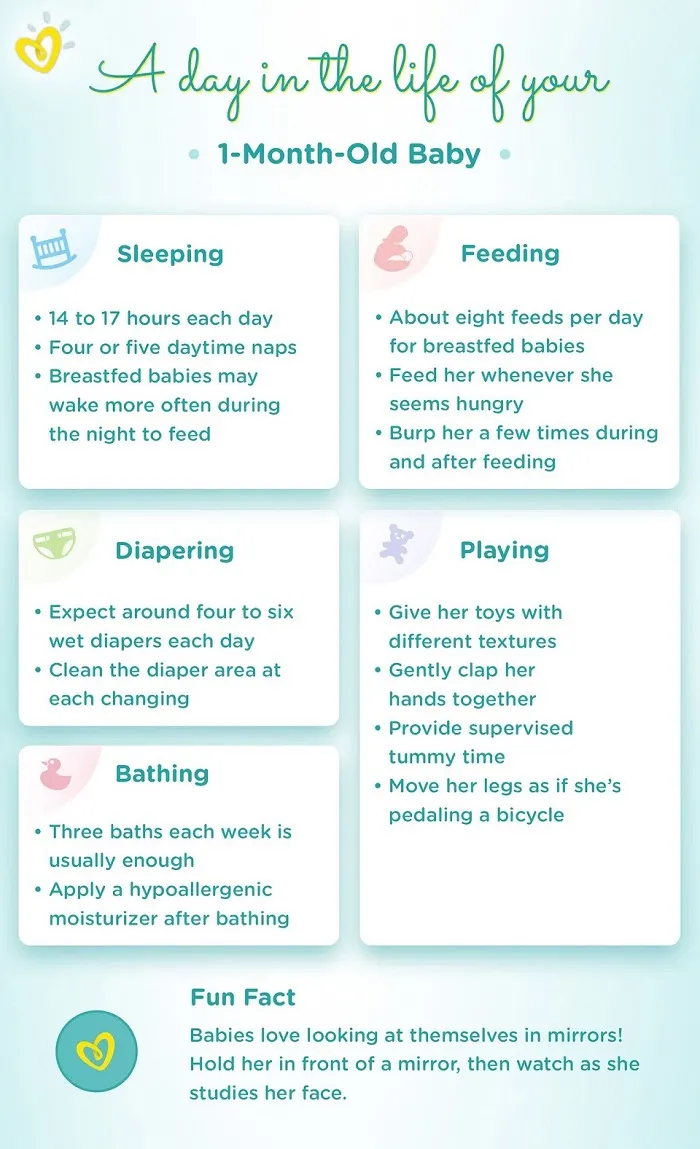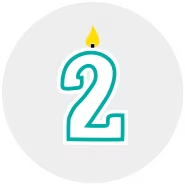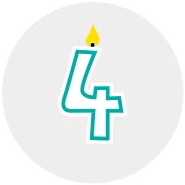3 Month Baby Milestones, Growth Tips, and Care Essentials to Support Their Development Journey
Life with your 3-month-old baby will be all about settling into the feeling of mother and fatherhood. You will find yourself establishing routines and spending more time with your lovely baby. Although there are a few things that might take time, you may be feeling a little more confident as new parents than the previous months.
As new baby milestones await in the upcoming months, we will take you through some of the 3-month-old baby development highlights that will answer most of your common questions. So, worry not; you may be short on sleep, but you are doing great! Still not sure? Read on to find out.

Baby Development Milestones
As you are getting acquainted with different baby milestones by month, you must know that many changes are happening as your baby grows. Your 3-month-old baby is now slightly more aware of her physical self and also the world around her. So, take a look at some of the 3-month-old baby milestones you do not want to miss out on!
Growth and Physical Development: Stronger Day-by-day
As your baby's bones and muscles develop, your little one can now stretch herself, letting you know how tall she is. The average weight of 3-month-old babies is approximately 680 to 900 gms, whereas the average height is about 2.5 to 4 cms. However, keep in mind that every baby is unique. Your little one will slowly be able to control her body movements.
Initially, most of your newborn's movements were involuntary reflexes, but now as she moves her head, hands or feet, her movements may be more intentional. As her neck becomes strong, soon she will begin holding her head up independently, and look at people and objects more keenly. Now that your baby's vision is improving, soon you may also notice her try and reach for things nearby or follow moving objects with her eyes.
Read more on the usage of baby growth charts during the first 24 months.
Senses: Building Blocks of Communication
You will discover a lot on this journey as your three month old is learning bit by bit. With your newborn baby’s vision improving, she is more aware of circular shapes and patterns like spirals and curls now. She also loves observing human faces, especially yours, as her favourite sight.
By now, your baby has probably associated your voice with comfort, soothing, and love. As time progresses, she is slowly becoming more aware of your tone and emphasis on certain words that she may try to mimic. She is realising that conversations are a two-way process as she is trying to understand other concepts of communication. She will be delighted to see your reaction as you watch her babble or see her joy while you sing or read to her.
Movement: A Full-Body Workout
By this time, the movement of many babies become more intentional. So, you will notice some of the exciting progress in your baby's motor skills. Stretching your baby's body helps strengthen her leg muscles, which will help her to roll over. Perhaps, there's still time for her to roll over, and it won't be until another 2-3 months – but hey, she's getting ready!
Your baby may be able to flex and straighten her legs on her own. Try placing her on her feet and support her under her arms - this is excellent preparation for standing. While doing so, if she is trying to bounce herself, let her do so, and you will see how proud she feels of her new ability.
Your baby can also open and shut her hands to hold toys or your fingers. Since she has gained a little better control of her arms, she may try to reach for objects and bat at something that catches her attention. She can also bring her hands to her mouth now, so you need to be extra cautious about keeping away all the hazardous stuff to avoid her reaching for them.
Another way to encourage her movement is to provide daily tummy time sessions. You can also try 3-month-old baby activities like handing toys to her or letting her grasp objects that hang from an infant gym or playpen to improve her motor development, hand-eye coordination, and other skills.
Personality: Your Baby's First “Conversations”
One of the best joys of parenthood is to watch your little one's personality flourish. Seeing your baby smile often and respond to your voice is one of the greatest feelings. As she enjoys her playtime with you and other family members, she can now express her joy through her facial expressions and body movements. You may also notice her imitating some of your movements and expressions. However, do not worry if your baby isn't there yet; all babies develop differently at their own pace.
Soon you will begin having conversations with your little one, then be it merely back-and-forth exchanges of sounds, smiles, and gestures. Those little chats you will have with your baby won't only be fun but also help her trust you while boosting her self-esteem. If there are other children in your neighbourhood, you will notice that she is interested and curious about them.
Babies have their own ways to make you aware of their needs, and you as a parent will realise your baby's subtle (and not-so-subtle) cues about her needs. Pay attention to the ways she communicates with you, as these are essential parts of her personality and temperament. For example, through her way of crying or body language, you can know her urgent needs. You can distinguish these cries and gestures from one another - her cries of hunger would be different than her cries of pain. You will also learn what calms her when she's simply fussing – it can be a favourite toy or an activity.

How to Support Your Baby's Development
Your baby's paediatrician will share several ways through which you can help foster your baby's development. These suggested activities will help encourage movement, making your baby master the required skills for rolling, sitting, and holding her head up. They will also promote her cognitive and sensory development. Here are some strategies and 3-month-old baby activities you can try:
Strengthen back and neck muscles: Place your baby on her tummy on a flat surface like a play mat or blanket for short sessions of tummy time. This will help her gain more control over the head, arms, and legs. Make sure you do so when you are close by and monitoring her.
Promote hand-eye coordination: Give your baby small objects like toys or your fingers to encourage her grasping skills. This skill will help her learn to bring her hands to her mouth successfully.
Aid visual development: During this month, her distance vision, colour vision, and tracking skills are all improving. So, introduce stimulating colours, textures, and patterns in the form of toys, colourful mobiles, playmats, books, and other activities.

Breastfeeding Tips Your 3-Month-Old Baby
3-month-old feedings may reduce as compared to their newborn days. It all depends on where their nourishment comes from – is it breast milk alone or the formula, or a combination of the two. Generally, babies at this age can consume more milk at every feeding than they used to in the last two months. So, the number of feedings become less frequent, probably six to eight feedings in 24 hours. Read here for few tips on how to burp your baby.
Tracking wet and dirty diapers
You can track diapers to monitor if your baby is feeding enough. She may be dirtying her diapers less often, and her stools may be more solid now. Initially, you may have changed the soiled diapers too frequently (maybe after every feeding), but now you may need to change it once per day or once every two to three days. The best way to know if your baby is feeding well is if she produces around six wet diapers every day. Given all the diapering going on, keep in mind that your baby’s fragile skin needs soft, comfortable diapers — such as Pampers Premium Care diapers for newborn.
Since your baby goes through a lot of diaper changes, her skin might be prone to diaper rash. So, make sure you use the one that is suitable for her delicate skin. You can try from a wide range of Pampers® diapers like New-Baby if you haven't already. Also, did you know you can now turn your diapers into rewards like gift cards, cashback, and more? Download the Pampers App for more. Read on to know more about how to change a diaper, and you will surely get the hang of it. You can also check the ultimate diaper bag checklist for you newborn baby.

How Much Sleep Does a 3-Month-Old Baby Need?
By this time, your baby's sleep habits may be changing. As she continues to grow, she's now able to eat more throughout the day, and hence she may require fewer or no night feedings. Since she's more alert during the day, she may be sleepier at night. Plus, she may also take two to three naps during the day. Although some babies sleep through the night, it doesn't apply to all babies and 'through the night' often refers to a stretch of about five or six hours.
How to Put Your Baby to Sleep
You can follow these guidelines when putting your baby to bed at night or for a daytime nap so that she sleeps safely and peacefully. It also reduces the risk of SIDS:
Always place your baby on her back while putting her to sleep
Avoid sleeping with baby in bed
Place your baby on a firm crib mattress without any loose bedding
Make sure your baby is dressed comfortably for room temperature
Place your baby with a pacifier.
Tips for a Good Night's Sleep
Try aiming for a consistent baby sleep schedule that suits you both. Here are some tips for a more peaceful and restful night:
Establish a routine: Help your 3-month-old wind down after the day's activities by singing a lullaby, giving her a gentle massage, or reading a story.
Let her squirm: Give your little one a minute to settle down and get comfortable. Let her babble, wriggle, or even cry just a bit before she dozes off.
Mise stimulation: Minimise or avoid any distractions while attending to your baby during the night. Try keeping the lights low, avoid talking very much during night-time feedings or other visits to calm her down, and let her drift back to sleep easily.

A Day in the Life of Your Baby
Be prepared for lots of surprises as your 3-month-old baby grows. We understand that following a set routine can be difficult, but take a look at this guideline for bathing, feeding, playing to add a little structure and fun to each day, and sleeping:

Your Baby's Health: Infant Care
Apart from your baby’s regular playtime activities, you can give your baby a massage to promote her health and wellness. Infant massage with the right techniques can reduce your baby's stress levels, possibly decrease the amount of crying while strengthening your bond with your baby.
Make sure you check with your baby's paediatrician first. He or she may also recommend some local classes in infant massages to help you with the basics. For starters, here are some basic techniques you can try:
Create a relaxing environment: Use your baby's changing table or your bed for the massage. Place your baby on her back and maintain eye contact while you begin the massage.
Use a gentle touch: Massage each part of her body from head, neck, shoulders to her waist, thighs, hands, and feet using gentle strokes.
Talk or sing to her: Talk softly or sing your baby's favourite song as you massage her. This will help make your baby feel more relaxed.
Gauge her reaction: If your baby seems to enjoy it, continue with the massage. But, if your baby seems restless or fussy, stop the massage, as she's probably not enjoying it.
Did you know, your baby’s poop can tell a lot about your baby’s health? Learn all about baby poop with this ultimate baby poop guide.
Keep in mind that wait for at least 45 minutes after feeding before you begin with the infant massage. If your baby enjoys this activity, you can continue it until the toddler years.
Development Tips for Your Baby This Month
Consider the following tips to help form a strong bond with your 3-month-old baby and foster a feeling of safety and security:
Consistently provide close physical contact. Hugging or cuddling your baby often can help increase their sense of safety and security. Make sure everyone in the household as well as other caregivers outside of the home provide similar loving care to your baby.
Read to your baby every day. Reading at this early stage not only boosts your baby’s language development but can help establish a lifelong love for reading and learning. Reading as part of a bedtime routine can also help calm and comfort your little one.
Show your baby colorful objects of different shapes, sizes, and textures. These items can be sensory toys, rattles, or plush toys (as long as the baby toys are appropriate for a 3-month-old). You may also like to show your baby simple picture books with different colors and patterns and family photo albums.
Talk to your baby throughout the day. Say your baby's name and use simple phrases to narrate what you’re doing when you're together, such as feeding, diapering, and bathing them. Respond to your baby when they make faces or gestures to encourage their attempts at "conversation." If you or your partner speak a foreign language, feel free to start using it with your baby.
Pay attention to your baby’s cues. Respond to your baby when they let you know that they're hungry, happy, upset, or tired. Your loving attention won’t spoil them.
Items You Will Need This Month
Here are some baby gear items you may want to purchase or acquire this month if you haven’t already:
Baby books. Dig out your favorite children’s books or head to the library or your local bookstore.
Baby swing. A baby swing is a great item to have on hand when you need to free your hands for a while and occupy your baby. The swinging motion can help calm a fussy baby and gently soothe them. If your baby falls asleep, move them to their crib.
Diapers, wipes, and diaper rash cream. You’ll always need diapering supplies, so stock up whenever you have the opportunity.
Baby pacifier. Some babies benefit from the use of a pacifier—it can serve as a soothing device especially as they fall sleep.
Baby monitor. If you don't already have a baby monitor, you might like to get one this month. There are many different models to choose from, including video camera baby monitors and ones that work with your smartphone.
Baby thermometer. Using a thermometer specifically designed for babies makes taking a temperature much easier.

FAQs at a Glance
It can take up to two to three months for the soft spot to close. However, remember that even after that your baby's head may still look proportionately larger than her body.

Your Life as a Parent: How to Deal with Sleep Deprivation
Most of the new parents share concerns regarding sleep deprivation. We understand that you want to be at your best for your baby, but sleep deprivation doesn't make it any simple. It is all about teamwork to easing things up a little bit - between you and your partner and other family members. You also need to prioritise important tasks.
One way to minimise your sleep deprivation is by sleeping during your baby's sleep routine. This means that putting the baby to bed isn't completely on you, and it gives you well-deserved me-time. This arrangement is also healthy for your baby, as she learns to sleep under slightly different circumstances every night and doesn't depend on your interaction to fall asleep anymore.
You can also prevent sleep deprivation with the following tips:
Split the task of night-time bottle feeding with your partner or other caregivers
Eat nutritious foods and stay hydrated
Sleep when your baby sleeps
Practise some light exercise, then be it going on a walk with your baby or running a short errand by yourself.
Checklist for This Month
If you haven’t already, schedule your baby’s next routine checkup. Your baby’s healthcare provider will track your baby’s growth, do a physical exam, ask you how you’re doing, answer any of your questions, and schedule or give any immunizations your baby may need. Learn more about your baby’s Vaccination Schedule.
Start looking ahead—check out what kinds of things may happen when your baby is 4 months old.





